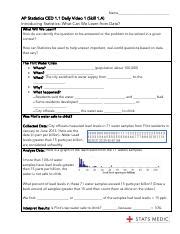Introduction

The Advanced Placement (AP) Statistics course provides students with a robust foundation in statistical methods and data analysis. The College Board’s redesigned CED (Course and Exam Description) for AP Statistics emphasizes critical thinking, problem-solving, and the application of statistical concepts to real-world scenarios. This comprehensive guide delves into the ins and outs of the AP Statistics CED, empowering educators and students to maximize their learning and exam performance.
Key Features of the AP Statistics CED
Focus on Statistical Thinking
- The CED places paramount importance on developing students’ statistical thinking abilities, equipping them with the skills to:
- Identify appropriate statistical methods for various research questions
- Critically evaluate and interpret statistical results
- Communicate their statistical findings effectively
Emphasis on Data-Based Decision Making
- The CED highlights the significance of data-based decision-making in contemporary society. Students learn to:
- Collect, analyze, and interpret data to solve problems
- Use statistical reasoning to justify their conclusions and make informed decisions
Integration of Technology
- The CED encourages the use of technology in statistical analysis, including:
- Statistical software for data manipulation and visualization
- Online databases and repositories for accessing real-world datasets
- Simulation tools for exploring statistical concepts
Benefits of the AP Statistics CED
College Readiness
- The AP Statistics CED aligns with introductory statistics courses in college, providing students with a head start in their higher education studies.
- According to the College Board, over 90% of colleges and universities accept AP Statistics scores for placement or credit.
Career Preparation
- The skills developed in AP Statistics are highly valued in various fields, including:
- Data analysis and research
- Business and finance
- Healthcare and public health
- Education and social work
Intellectual Development
- AP Statistics fosters critical thinking, problem-solving, and communication skills that are essential for academic and personal success.
- Students learn to approach problems from a statistical perspective and develop a deeper understanding of the world around them.
Applications in Real-World Scenarios
The versatility of statistical methods makes AP Statistics applicable across a wide range of fields. Here are a few innovative applications:
- Healthcare: Analyzing patient data to predict disease risk and develop treatment plans
- Marketing: Using statistical models to identify target audiences and optimize marketing campaigns
- Government: Conducting surveys to gauge public opinion and inform policy decisions
- Education: Assessing student learning outcomes and improving teaching methods
Common Mistakes to Avoid
- Lack of Comprehension: Failing to understand the underlying concepts of statistical methods
- Misapplication of Methods: Using inappropriate statistical methods for the given data or research question
- Incorrect Data Interpretation: Misinterpreting or misrepresenting statistical results
- Neglecting Assumptions: Ignoring the underlying assumptions of statistical methods, which can lead to unreliable conclusions
- Overreliance on Technology: Relying solely on technology without developing a solid understanding of statistical theory
Conclusion
The AP Statistics CED empowers students with critical thinking, problem-solving, and data analysis skills that are vital for success in college, careers, and life. By embracing the key features and applications of the CED, educators and students can harness the transformative power of statistics to make informed decisions, solve complex problems, and contribute to a data-driven society.
Additional Resources:
- College Board AP Statistics CED: https://apcentral.collegeboard.org/courses/ap-statistics
- Khan Academy AP Statistics: https://www.khanacademy.org/math/ap-statistics
- The Princeton Review AP Statistics: https://www.princetonreview.com/ap-test-prep/ap-statistics-prep
Tables
Table 1: Key Concepts in AP Statistics
| Concept | Description |
|---|---|
| Descriptive Statistics | Summarizing and describing data |
| Probability | The likelihood of an event occurring |
| Statistical Inference | Making conclusions about a population based on a sample |
| Hypothesis Testing | Determining whether there is evidence to reject a claim |
| Regression Analysis | Modeling the relationship between variables |
Table 2: Benefits of AP Statistics
| Benefit | Description |
|---|---|
| College Readiness | Prepares students for introductory statistics courses in college |
| Career Preparation | Develops skills valued in various fields |
| Intellectual Development | Fosters critical thinking, problem-solving, and communication skills |
| Real-World Applications | Equips students with statistical knowledge for data-informed decision-making |
Table 3: Data Science Applications of AP Statistics
| Field | Application |
|---|---|
| Healthcare | Predicting disease risk, optimizing treatment plans |
| Marketing | Identifying target audiences, optimizing marketing campaigns |
| Government | Gauging public opinion, informing policy decisions |
| Education | Assessing student learning outcomes, improving teaching methods |
Table 4: Common Mistakes in AP Statistics
| Mistake | Description |
|---|---|
| Lack of Comprehension | Failing to understand the underlying concepts of statistical methods |
| Misapplication of Methods | Using inappropriate statistical methods for the given data or research question |
| Incorrect Data Interpretation | Misinterpreting or misrepresenting statistical results |
| Neglecting Assumptions | Ignoring the underlying assumptions of statistical methods, which can lead to unreliable conclusions |
| Overreliance on Technology | Relying solely on technology without developing a solid understanding of statistical theory |
